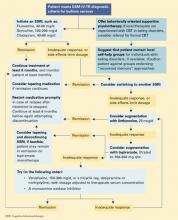Topiramate. A newer augmentation strategy is to add the anticonvulsant topiramate. Used alone, topiramate demonstrated effectiveness for bulimia nervosa in one placebo-controlled, double-blind trial.16
Adding topiramate to an antidepressant regimen will likely reduce any remaining bulimic symptoms. In addition, topiramate often produces weight loss—a side effect that bulimic patients usually welcome. It remains unclear whether topiramate’s weight-loss effects might pose a hazard in patients with simultaneous bulimic and anorexic symptoms.
Other antidepressants. If the above strategies fail, other antidepressant options include venlafaxine, tricyclics, and monoamine oxidase inhibitors. Bupropion is not recommended in bulimia nervosa; one trial17 of this agent resulted in a much higher rate of grand mal seizures in bulimic patients than in patients taking bupropion for depression.
In bulimic patients with concomitant bipolar disorder, the anticonvulsants carbamazepine and valproate often reduce affective and bulimic symptoms. By contrast, the anticonvulsant phenytoin—once thought to be useful in bulimia nervosa10 —offers little benefit for either bulimic or affective symptoms.
Persistence is important when initial medication trials fail. One unblinded study followed 36 bulimic patients 9 to 19 months after they completed a controlled study with trazodone.18 Of the 26 patients who tried a second or third antidepressant, 17 (65%) achieved remission of bulimia on follow-up. Of the 10 patients who declined a second or third trial, only 1 (10%) attained remission.
Notably, these study results were obtained before the SSRIs and other newer antidepressants or topiramate became available. Cooperative patients using present-day medications might be able to achieve remission rates that exceed 65%.
Algorithm Proposed treatment approach to bulimia nervosa
Table 3
How effective are psychotherapies in treating bulimia nervosa?
| Psychotherapy | Evidence for efficacy | Remarks |
|---|---|---|
| Cognitive behavioral therapy (CBT) | +++ | Controlled evidence for efficacy in individual and group treatment |
| Interpersonal psychotherapy (IPT) | ++ | Effective, but slower than CBT |
| Exposure with response prevention | + | May be added to other behavioral techniques, though additive benefit questionable |
| Dialectical behavior therapy | + | Highly structured behavioral technique originally developed for borderline personality disorder |
| Self-help groups | + | Frequently considered very helpful by patients |
| Psychodynamic psychotherapy | 0 | “Recovered memory” approaches are frankly harmful |
| Eye movement desensitization and reprocessing (EMDR) | 0 | Dubious theoretical basis; no methodologically acceptable evidence for efficacy |
| 0 No apparent efficacy | ||
| + Occasional effect; limited evidence | ||
| ++ Clear effect; good evidence from controlled trial(s) | ||
| +++ Strongly documented effect; evidence from multiple controlled trials. | ||
Psychotherapy
Cognitive-behavioral therapy. CBT—given either individually or in groups—is the most effective psychotherapy for bulimia (Table 3).19 CBT typically involves 3 to 6 months of helping the patient focus on her bulimic behaviors and on specific attitudes—such as unrealistic preoccupations with being “too fat”—that perpetuate the behaviors.
In practice, unfortunately, few bulimic patients are offered CBT, perhaps because few clinicians are trained in the specific approach used for bulimia nervosa.19 If you are not trained in using CBT for bulimia and do not have access to colleagues who offer this treatment, you may begin with medication plus simple behavioral treatments, such as:
- offering supportive therapy in the office
- referring patients to self-help groups for persons with eating disorders.
If this strategy fails, encourage patients to consider CBT—even if they must travel some distance to obtain it.
Other specialized psychotherapies. Dialectical behavior therapy and interpersonal psychotherapy appear to be effective in bulimia. Again, however, clinicians who lack training in these techniques or access to local experts may be unable to offer them. Psychodynamic therapy does not appear to offer greater benefit in bulimia nervosa than ordinary supportive counseling.
Dubious therapies. One psychodynamic approach—regrettably still practiced—is “recovered memory therapy.” Therapists who use it claim that childhood sexual abuse or other trauma can cause bulimic symptoms but patients have repressed the memory of these events.20
No methodologically sound evidence has shown that childhood sexual abuse can cause bulimia nervosa years or decades later.21 Nor is there acceptable evidence that people can repress the memory of a traumatic experience.22 Therapists administering recovered memory therapy have been subjected to malpractice judgments totaling tens of millions of dollars from suits filed by patients who eventually realized that so-called “recovered” memories were false.23
Another dubious therapy—eye movement desensitization and reprocessing (EMDR)—also may involve attempts to “recover” memories of putative traumatic events.24 No methodologically sound evidence has shown that EMDR is effective in bulimic patients, and the technique’s theoretical basis is questionable.24,25
Related resources
- Mental Health Net/Eating disorders. http://eatingdisorders.mentalhelp.net
- National Association of Anorexia Nervosa and Associated Disorders (ANAD). www.altrue.net/site/anadweb/
- Association for Advancement of Behavior Therapy. www.aabt.org
Drug brand names
- Bupropion • Wellbutrin
- Citalopram • Celexa
- Desipramine • Norpramin
- Fluoxetine • Prozac
- Lithium • Lithobid, Eskalith
- Nortriptyline • Pamelor, Aventyl
- Sertraline • Zoloft
- Topiramate • Topamax
- Trazodone • Desyrel
- Liothyronine • Cytomel
- Venlafaxine • Effexor
Disclosure
Dr. Pope receives research support from Ortho-McNeil Pharmaceuticals and is a consultant to Solvay Pharmaceuticals and Auxilium Pharmaceuticals.


